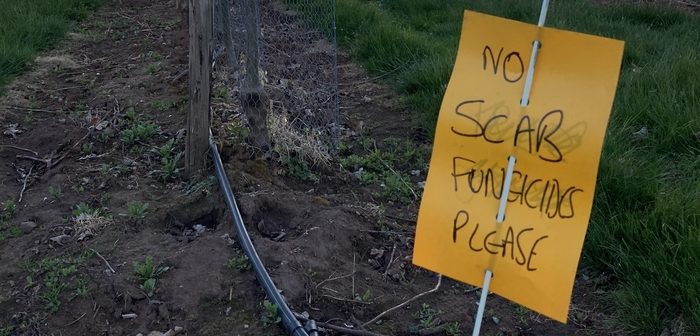Controlling scab in apple orchards is becoming increasingly challenging as chemical options become more restricted, but trials by leading agronomy firm Hutchinsons could help growers get more from the remaining armoury
The unique research aims to discover whether elicitor products can be used to trigger a plant’s natural defence against the scab pathogen Venturia inaequalis and ultimately reduce the reliance on chemical controls within an integrated control strategy.
“Every manufacturer claims that elicitor products work well, but there’s very little data to compare the extent of scab resistance they confer, so we want to address that,” says Hutchinsons agronomist Rob Saunders, who is managing the study alongside his colleague Nigel Kitney.
A comparison trial has been set up in a Gala orchard adjacent to the Hutchinsons HELIOS site in Gloucestershire, where different elicitor products are being assessed in replicated plots, managed by Oxford Agricultural Trials.
“Some products have not reached the market yet, while others are more established,” says Mr Saunders. “The products under review work in different ways, but of most interest are those which ‘switch-on’ the immune system within plants.”
There is no known way of triggering the immune response before bud break, so standard scab fungicides have been applied from the beginning of the season. Once sufficient green tissue had developed, elicitor products were introduced into the programme, while still being supported with conventional scab chemistry, Mr Saunders explains.
“The idea is that once the plant’s immunity is fully switched on, we can stop applying the conventional chemistry and rely on the plant to look after itself while scab pressure is low or moderate, using disease modelling to predict when scab pressure will exceed a threshold value and require support from further fungicide treatment. It’s truly integrated crop management.”
With the loss of actives such as mancozeb and thiram, plus tighter restrictions on the maximum application amounts and rates of others like captan and dithianon, it is becoming increasingly important to find ways of utilising all chemistry as effectively as possible, he adds.
Overcoming spraying challenges
Improving the plant’s in-built disease defence could also help overcome some of the potential issues associated with applying traditional scab fungicides, particularly those concerning spray coverage and timeliness, Mr Saunders says.
“Good spray coverage is absolutely vital for conventional fungicides, however whenever you get any shading effect from flowers or leaves, there’s an area of tissue that doesn’t get treated, which has potential for scab to get in.
“But, if we can ‘switch-on’ the immune system, then the repercussions of having small areas untreated are hopefully less significant. The same applies if treatment intervals have to be extended due to delays caused by adverse weather.”
Products in the trial will be compared against an untreated control and a full conventional scab control programme, with all crops taken to harvest this autumn when yield and quality assessments will be made.
“Our primary focus is on controlling scab rather than increasing yield, but we may see improved marketable yield as scab is the primary concern for blemish-free fruit. We will also be looking for any effect on leaf quality and tree physiology,” notes Mr Saunders.
“Ultimately, we hope to provide our agronomists with more information about the strongest elicitor products and the extent of their robustness, so they can give growers confidence to manage orchards with less reliance on conventional fungicides in the future. This research could well have a significant impact on orchard management going forward.”




